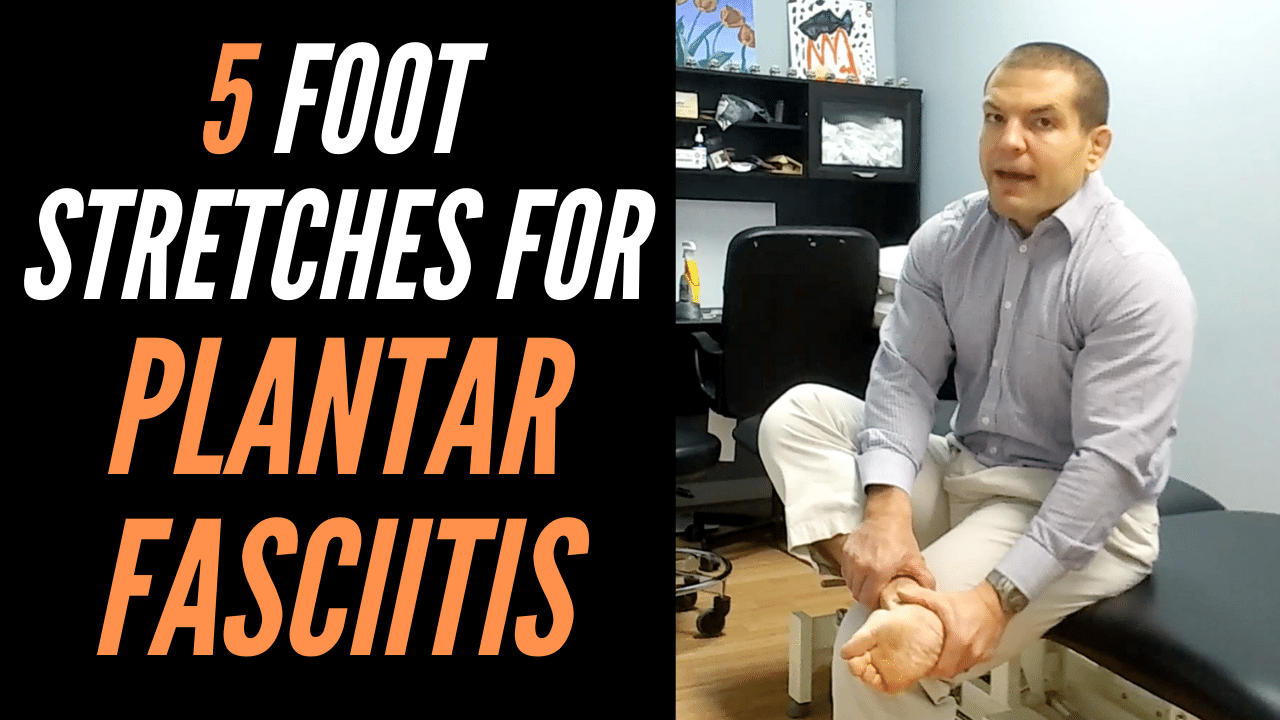Want To Learn How To Stretch For Plantar Fasciitis?
Watch the video below to learn 5 Uncommon Foot Stretches For Plantar Fasciitis that even most physical therapists don't know...
Most People Don't Understand How To Stretch For Plantar Fasciitis Correctly
Calf stretches and heel raises are the most commonly prescribed exercises for plantar fasciitis, but even these are often done with the wrong technique, making them less effective than they could be.
Even more common though, the foot is often overlooked! To relieve foot pain such as plantar fasciitis, it makes sense that you would actually want to stretch the foot 🤦♂️
...even though calf stretches and heel raises are still great exercises for plantar fasciitis.

5 Uncommon Foot Stretches For Plantar Fasciitis
As mentioned previously, the most common exercises for plantar fasciitis are actually calf or ankle stretches, especially if you get an exercise handout from your primary care doctor or an orthopedic surgeon.
Sometimes those handouts will contain one or two foot stretches as well.
The most common foot stretches for plantar fasciitis include:
- Rolling your foot on a golf ball, tennis ball, or frozen water bottle.
- Picking up marbles with your toes
- Scrunching a towel using your toes
- Pulling the toes backward to stretch the arch
This first exercise is OK.
Rolling your foot on a tennis ball or frozen water bottle does help relieve some of the trigger points (tender points) in the foot muscles. However, they're not really pinpoint enough to get down to the small joints in the midfoot that are one of the major causes of plantar fasciitis.
The ice feels good because it temporarily numbs your foot, but often the term plantar fasciitis is poorly used as -itis means inflammation and in most cases of "plantar fasciitis" there's actually no inflammation found on MRIs... so there's really no need to ice it other than just short-term relief.
The golf ball DOES get to the small joints in your foot, but if you've ever rolled your foot on a golf ball, IT HURTS... even if you don't have plantar fasciitis. Try Foot Stretch #2 instead.
The marbles pick-ups and towel scrunches?... Don't bother
Without getting into too much anatomical detail, these work on your toes muscles, but NOT the ones that support your arch. Try Foot Stretch #5 below instead
Pulling the toes back to stretch the plantar fascia?
This one is pretty good. It's actually similar to Foot Stretch #4 below. However, it's probably more the muscles that attach to the plantar fascia than the plantar fascia itself that you're stretching. It's also important to pull the WHOLE forefoot back, not just the toes. The video above provides a good explanation of why this is important at 3:32.
How To Do The 5 Foot Stretches For Plantar Fasciitis
*Sit with your heel crossed over your opposite knee for each of these 5 stretches.
Foot Stretch #1 - To help absorb shock better
- Stabilize ankle with one hand
- Take the palm of your other hand and put it on the inside of your heel
- Push down towards the floor (there should be a tiny movement)
Foot Stretch #2 - To help re-dome your up & down arch
- Put pressure on the middle of your arch, finding a tender spot
- Fold arch over and pull your toes down
Foot Stretch #3- To help re-dome your side-to-side arch
- Put your thumbs in the middle of your arch
- Wrap your other fingers around the top of your foot
- Fold your arch side-to-side (like hot dog bun)
Foot Stretch #4- Helps stretch the muscles on the bottom of the foot and plantar fascia itself
- Pull your toes and the arch of your foot back towards the top part of your foot
- Make sure to pull the whole forefoot, not just the toes in order to stretch your intrinsic foot muscles. If you only pull the toes, you're stretching your long toe flexors, which originate in your lower leg.
Foot Stretch #5- This exercise helps strengthen the muscles that support your arch
- Curl your toes inward
- Scoop foot inward and upward
- Relax and repeat
So those were the the 5 foot stretches for plantar fasciitis. By implementing those regularly, along with likely stretching your calves, you can make a considerable improvement in your plantar fasciitis.
However if you need more help for plantar fasciitis, we'd be happy to help you here at More 4 Life. Just tap the button below to request an appointment with one of our specialist physical therapists.
Looking for orthotics? If you're just interested in orthotics for plantar fasciitis, click here to request a Free Foot Scan for custom orthotics.
Need a stretching device for plantar fasciitis?
I find that most people actually don't need a stretching device for plantar fasciitis.
The exercises above, along with calf stretches are usually good enough if done consistently, along with wearing proper shoes and/or orthotics, and correcting standing posture, walking pattern, and other repetitive activities that you do while on your feet.
However, for some people buying a stretching device motivates them to actually do their stretches.
Life gets busy, and its easy to forget about stretching.
But if you see the stretching device just sitting there in your living room, it might just remind you to get up off the couch and do your stretches while watching TV instead of just sitting there.
If you need a stretching device for plantar fasciitis, I recommend the ProStretch Double:
ProStretch Double Original Calf Stretche...
$45.99 (as of July 25, 2024 23:00 GMT -05:00 - More infoProduct prices and availability are accurate as of the date/time indicated and are subject to change. Any price and availability information displayed on [relevant Amazon Site(s), as applicable] at the time of purchase will apply to the purchase of this product.)There is a single version, but I highly recommend the DOUBLE for a few reasons:
- It's too easy to pronate your foot when stretching one side at a time, meaning you're not going to get the proper stretch. (Main reason)
- Most people are tight in both calves and so you can stretch both calves at the same time.
- If you MUST do one leg at a time (not recommended) you can still do that on this model.
Like this post? Here are a few other posts about plantar fasciitis that you may enjoy:
When Is Foot Arch Pain Not Plantar Fasciitis?
Is My Heel Pain Achilles Tendonitis vs Plantar Fasciitis?



